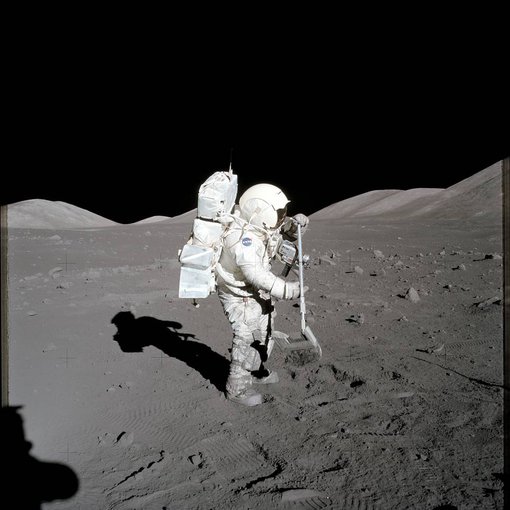
Jan. 16, 2020
Research Highlight
The Loss of Zinc on the Moon
A recent study supported in part by the NASA Astrobiology Program is helping researchers understand the evolution of the Moon’s surface. Scientists performed an isotopic study on lunar basalts, materials that formed on the Moon during the rapid cooling of magma. The samples came from meteorites as well as materials returned to Earth by the Apollo missions.

Scientist-astronaut Harrison H. Schmitt, Apollo 17 lunar module pilot, collects lunar rake samples at Station 1 during the mission's first spacewalk at the Taurus-Littrow landing site. This picture was taken by astronaut Eugene A. Cernan, commander. The lunar rake, an Apollo lunar geology hand tool, is used to collect discrete samples of rocks and rock chips ranging in size from one-half inch (1.3 centimeters) to 1 inch (2.5 centimeters).Image credit: NASA.
The team examined zinc (Zn) and chlorine (Cl) isotopes across the samples to determine whether or not “incompatible element enriched rocks” (known as KREEP) contain evidence of the last highly differentiated melts on the Moon. The resulting data supports models that suggest the Moon lost Zn and other volatile elements due to planetary processes following its formation. This could include events like giant impacts or magma differentiation.
The study, “Mare basalt meteorites, magnesian-suite rocks and KREEP reveal loss of zinc during and after lunar formation,” was published in the journal Earth and Planetary Science Letters. This work was supported by the Emerging Worlds Program. The NASA Astrobiology Program provides resources for Emerging Worlds and other Research and Analysis programs within the NASA Science Mission Directorate (SMD) that solicit proposals relevant to astrobiology research. This research is a critical part of NASA’s work to understand the Universe, advance human exploration, and inspire the next generation. As NASA’s Artemis program moves forward with human exploration of the Moon, the search for life on other worlds remains a top priority for the agency.